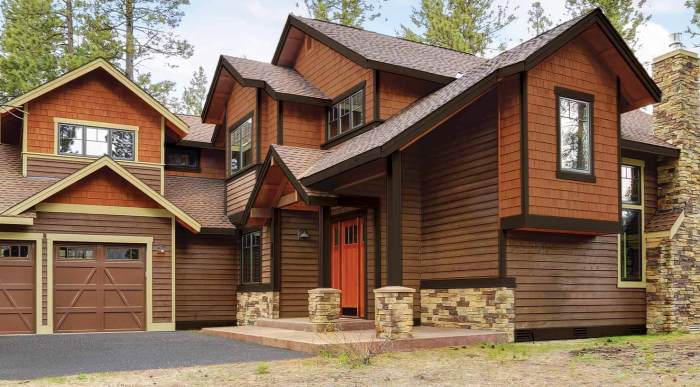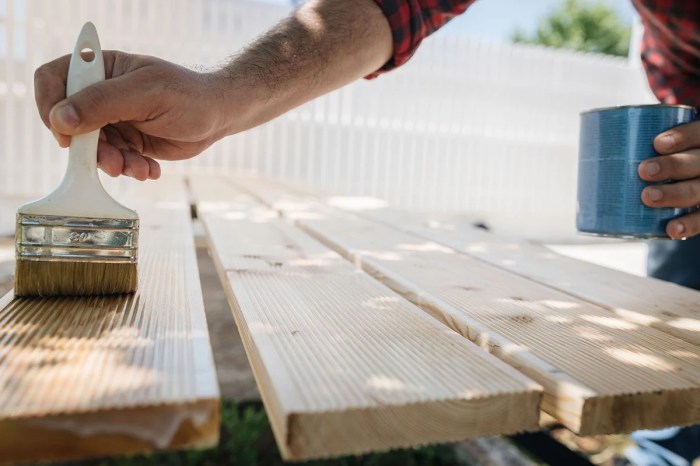Exploring the world of exterior wood stain opens up a realm of possibilities for enhancing and protecting your outdoor wooden surfaces. From understanding its purpose to delving into application techniques, this guide will equip you with all the knowledge you need to make informed decisions.
As we navigate through the nuances of exterior wood stain, you'll uncover insights that will transform the way you approach staining projects, ensuring lasting beauty and durability for your wood surfaces.
Introduction to Exterior Wood Stain

Exterior wood stain is a type of coating applied to wood surfaces to enhance their appearance, protect them from the elements, and prolong their lifespan. Unlike paint, which forms a thick film on the surface, wood stain penetrates the wood fibers to provide a more natural look while still offering protection.
Benefits of Using Exterior Wood Stain
- Enhances the natural beauty of wood grain
- Provides protection against UV rays, moisture, and mildew
- Preserves the wood by preventing rot and decay
- Allows the wood to breathe and expand/contract naturally
Different Types of Exterior Wood Stains
There are various types of exterior wood stains available in the market, each with its unique characteristics:
- Semi-transparent: Allows some wood grain to show through
- Transparent: Provides minimal color but enhances wood grain
- Solid color: Covers the wood completely with an opaque finish
- Clear: Offers protection without changing the wood's appearance
Exterior Wood Stain vs. Paint
While paint sits on the surface of the wood, exterior wood stain penetrates the wood fibers, allowing for a more natural look. Stain also requires less maintenance over time, as it does not chip or peel like paint. Additionally, stain allows the wood to age gracefully and develop a patina, unlike paint that may need frequent touch-ups.
Factors to Consider Before Staining
Before choosing an exterior wood stain, there are several important factors to consider to ensure the best results for your project.
Surface Preparation
Proper surface preparation is essential before applying any exterior wood stain. This includes cleaning the wood surface thoroughly to remove dirt, dust, and debris. Sanding the wood to create a smooth surface and remove any previous coatings is also crucial.
Failing to prepare the surface adequately can result in an uneven finish and poor adhesion of the stain.
Weather Conditions
Weather conditions can significantly impact the staining process and the final results. It is essential to choose a time when the weather is dry and mild, with temperatures ideally between 50-90 degrees Fahrenheit. Avoid staining wood in direct sunlight or high humidity, as this can lead to uneven drying and poor absorption of the stain.
Choosing Color and Finish
When selecting an exterior wood stain, consider the color and finish that will complement the overall look of your outdoor space. Take into account the natural color of the wood and any existing elements in your outdoor environment. Test different stain colors on a small, inconspicuous area of the wood to see how they will appear once applied.
Additionally, choose a finish that suits your desired level of sheen and protection for the wood.
Application Techniques
When it comes to applying exterior wood stain, there are various techniques that can be used to achieve a beautiful and long-lasting finish. It is important to choose the right method based on the type of wood, the desired outcome, and personal preference.
Brushing
Brushing is a traditional method of applying wood stain that provides good control and coverage. It allows for the stain to penetrate the wood fibers effectively, resulting in a rich and even finish. To brush on the stain, use a high-quality brush and apply even strokes in the direction of the wood grain.
Spraying
Spraying is a faster method of applying wood stain that can cover large areas quickly
Wiping
Wiping involves applying the stain with a rag or cloth, allowing for more control over the intensity of the color. This method is great for achieving a lighter or more subtle finish, and it can also be used to blend different stain colors together.
Make sure to wipe in the direction of the wood grain to avoid streaks or uneven patches.
Tips for a Consistent Finish
- Properly prepare the wood surface by sanding and cleaning it before applying the stain.
- Apply the stain in thin, even coats to prevent drips or pooling.
- Work in small sections to ensure that the stain is absorbed uniformly.
- Allow each coat to dry completely before applying additional coats.
- Use a brush, sprayer, or rag that is appropriate for the type of stain being used.
Importance of Following Manufacturer’s Instructions
It is crucial to follow the manufacturer's guidelines for application to ensure the best results. These instructions may include recommendations for preparation, application methods, drying times, and additional coats. By following these guidelines, you can achieve a professional finish that enhances the natural beauty of the wood while providing protection against the elements.
Maintenance and Care
After staining your exterior wood surfaces, it is important to follow proper maintenance and care routines to ensure the longevity and beauty of the finish.
Frequency of Reapplication
Depending on the type of wood stain used and the exposure of the wood to elements, it is recommended to reapply exterior wood stain every 2-5 years for optimal protection and appearance.
Cleaning and Protection Tips
- Regularly clean the stained wood surface with a mild detergent and water to remove dirt and grime.
- Avoid using harsh chemicals or abrasive cleaners that can damage the stain.
- Apply a fresh coat of exterior wood stain when you notice the color fading or the wood becoming dull.
- Consider applying a clear sealant over the stained wood to provide an extra layer of protection against moisture and UV rays.
Importance of Regular Inspections
Regularly inspecting your stained wood surfaces is crucial to identify any signs of wear, damage, or discoloration early on. This allows you to address any issues promptly and maintain the effectiveness of the stain.
Concluding Remarks

In conclusion, exterior wood stain serves as a vital tool in preserving the natural beauty of wood while providing essential protection against the elements. Armed with the information shared in this guide, you're now ready to embark on your staining journey with confidence and expertise.
Detailed FAQs
How often should I reapply exterior wood stain?
It is generally recommended to reapply exterior wood stain every 2-3 years for optimal protection and longevity.
Can exterior wood stain be used on pressure-treated wood?
Yes, exterior wood stain is suitable for use on pressure-treated wood after allowing it to weather and dry out for a few months.
What is the difference between semi-transparent and solid exterior wood stains?
Semi-transparent stains allow the wood grain to show through, while solid stains provide more color coverage and opacity, resembling paint.












